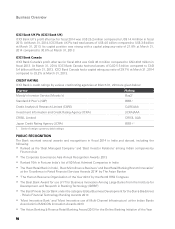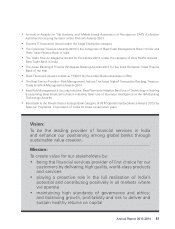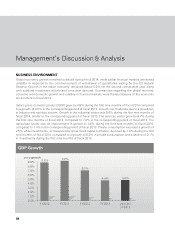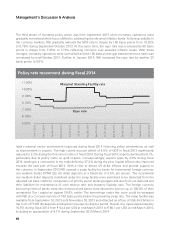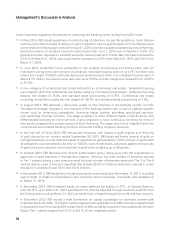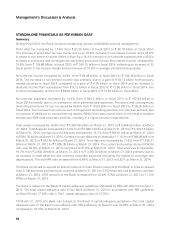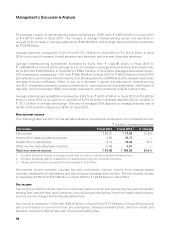ICICI Bank 2014 Annual Report Download - page 63
Download and view the complete annual report
Please find page 63 of the 2014 ICICI Bank annual report below. You can navigate through the pages in the report by either clicking on the pages listed below, or by using the keyword search tool below to find specific information within the annual report.Annual Report 2013-2014 61
Indian equity markets improved during fiscal 2014, though there were periods of high volatility during the
year. The benchmark equity index, the BSE Sensex, increased by 18.8% during fiscal 2014, moving from
18,836 at March 31, 2013 to a low of 17,906 on August 21, 2013 and subsequently rising to 22,386 at
March 31, 2014. As per the Securities and Exchange Board of India, foreign institutional investment (FII)
flows were significantly lower in fiscal 2014 with net inflows of around US$ 9.07 billion compared to net
inflows of US$ 27.58 billion during fiscal 2013. There were net inflows of US$ 13.69 billion in equity and
net outflows of US$ 4.62 billion in debt markets during fiscal 2014. Foreign direct investments improved
marginally to US$ 20.98 billion and external commercial borrowings to US$ 5.81 billion during the first
nine months of fiscal 2014, compared to US$ 19.78 billion and US$ 4.47 billion, respectively, during the
corresponding period of fiscal 2013.
Non-food credit growth remained subdued during fiscal 2014, with a growth of 14.5% year-on-year at
March 21, 2014 compared to 13.9% at March 22, 2013. Based on sector-wise credit data available as of
February 21, 2014, year-on-year growth in credit to industry was 13.2% and to the services sector was
17.1%. Credit to the infrastructure sector grew by 13.1% compared to 19.7% at February 22, 2013. Retail
loan growth increased to 16.5% from 14.6%. Deposit growth was 14.6% year-on-year at March 21, 2014,
compared to 14.2% growth at March 22, 2013. Demand deposit growth improved to 8.8% year-on-year
at March 21, 2014, compared to 5.9% at March 22, 2013.
First year retail premium underwritten in the life insurance sector (on weighted received premium basis)
was ` 454.29 billion in fiscal 2014 as compared to ` 470.19 billion in fiscal 2013. Gross premium of
the non-life insurance sector (excluding specialised insurance institutions) grew by 12.7% to ` 728.53
billion during fiscal 2014 from ` 646.53 billion during fiscal 2013. The average assets under management
of mutual funds increased by 10.8% from ` 8,166.57 billion in March 2013 to ` 9,045.49 billion in
March 2014.
Banking regulation underwent several changes during fiscal 2014 with several more measures proposed
to be implemented going forward. In the second quarter monetary policy review announced on October
29, 2013, RBI outlined five areas that would be the focus for developmental measures to be announced
in the short to medium term. These include the following:
• Strengthening and clarifying the monetary policy framework. In this regard, the recommendations
of the Urjit Patel Committee to Revise and Strengthen Monetary Policy Framework were considered
and implementation was initiated during fiscal 2014. Key proposals include adopting the consumer
price index (CPI) as the key inflation measure for monetary policy action, keeping the economy
on a disinflationary glide path with a target of 8.0% CPI inflation by January 2015 and 6.0% by
January 2016, transition to a bi-monthly monetary policy cycle, and progressive reduction in banking
system access to overnight liquidity under the LAF and corresponding increase in access to liquidity
through term repos.
• Strengthening the banking structure through entry of new banks, branch expansion, encouraging new
varieties of banks, and clarifying an organisational framework for foreign banks. In this regard, two
new banks were given in-principle licenses during fiscal 2014.
• Broadening and deepening financial markets and increasing their liquidity and resilience.
• Expanding access to finance to small and medium enterprises, the unorganised sector, the poor and
the remote underserved areas. RBI appointed a Committee on Comprehensive Financial Services for
Small Businesses and Low-Income Households which submitted its recommendations in March 2014
and has proposed, among other things, allowing setting up of specialised payments and wholesale
banks, and a new framework for priority sector lending.
• Strengthening real and financial restructuring and debt recovery from corporates and improving the
system’s ability to deal with distress.







